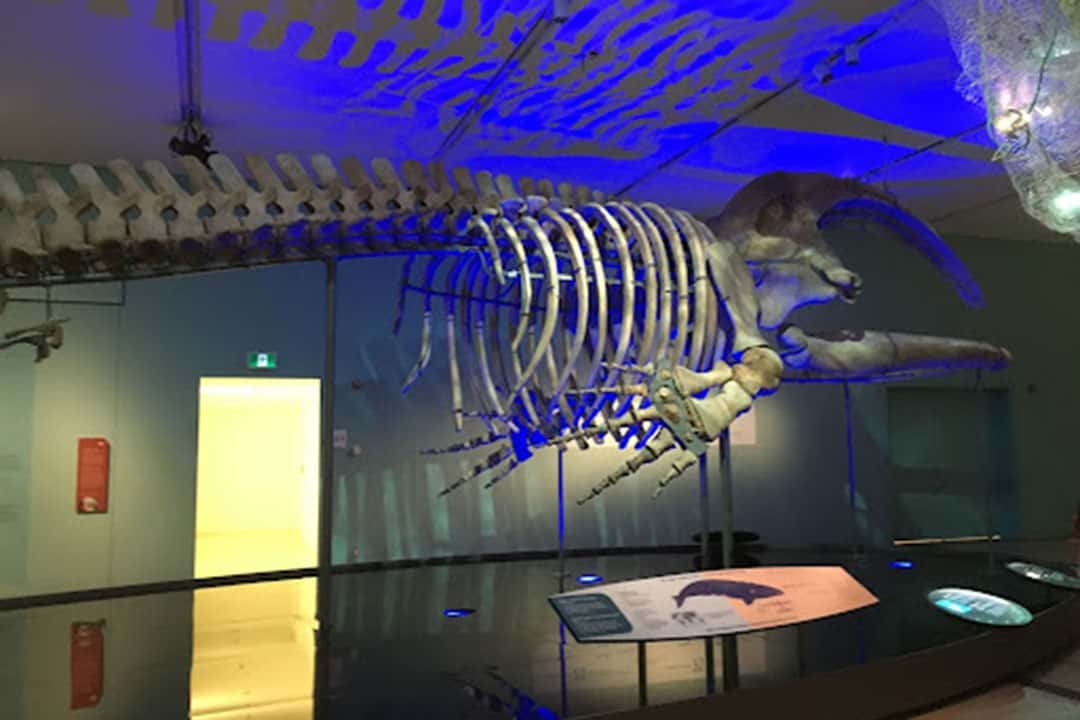The first time I visited the Royal Ontario Museum (ROM), I was about six or seven. At that point in time, I was exclusively obsessed with seeing dinosaurs, since I’d received a new National Geographic book on the subject. I can’t remember the experience of visiting the museum, but I do remember the sheer awe I felt while looking up at the colossal prehistoric skeletons.
When I had the opportunity to visit the ROM again this summer, nearly 14 years later, I wasn’t sure that the museum would strike me differently than on my previous viewings. Of course I was excited, but when you’ve been to a museum once, you’ve seen all there is to see, right?
Wrong. The ROM is constantly updating its collection of artefacts. As such, that same childish sense of bewilderment I thought I’d lost was rejuvenated at the ROM’s newest exhibit — Great Whales: Up Close and Personal.
Upon diving into the exhibit, which was enveloped in a dim blue light, I was greeted by the unfathomably large skeleton of a sperm whale. I hadn’t expected to be rendered speechless so early into the exhibit, but in that moment — and for the majority of the time I spent exploring the exhibit — the only word I could utter was a bewildered “wow.”
The name ‘great whales’ refers to the enormity of these species of whales, some of the largest creatures alive today. The exhibit tells the stories of three unique ocean giants: the rare North Atlantic right whale, the deep-diving sperm whale, and the massive blue whale — a creature which the ROM has featured before in a similar 2017 exhibition.
Walking by the whale skeletons, organs, and artefacts within the exhibit was incredibly humbling. Despite their power and enormity, whales are still incredibly vulnerable, and their beauty was only heightened by the incredible stories the exhibit dislplayed alongside their bodies. The exhibit brings new experiences and sparks long-forgotten curiosities about the deep blue world beneath us. Despite the fact that some interactive features have been closed for safety reasons, the exhibit is certainly one to behold.
The largest skeleton featured in the exhibit belongs to a blue whale named Blue, who was one of three whales whose bodies washed upon Mi’kmaw homelands in Newfoundland. Although their deaths were tragic, the whales washing ashore gave researchers the opportunity to study these creatures. The skeleton of Blue alone is massive, spanning 25 metres long, and taking up the full height of the exhibition hall.
Much of the feat that is the Great Whales exhibit is a product of research collected by members of the ROM team. Most notably, Jacqueline Miller, a mammalogy technician at the ROM, travelled to Canada’s East Coast to salvage the incredible blue whale heart and the skeleton of a North Atlantic right whale, both of which are now preserved and featured within the exhibit. Throughout the exhibit, visitors can listen to recordings of Miller recounting her experiences working with these creatures, which makes for a truly immersive experience.
One of the many notable parts of the exhibit includes the model of a sperm whale brain. With the largest brains of any animal, sperm whales are incredibly intelligent. Their brains have more grooves and folds than human brains, suggesting higher complexity. Such intelligent creatures have complex systems of communication, but they rely on a lack of noise pollution to be effective — another reason we need to be mindful of our impact upon the world.
Not only does Great Whales attempt to preserve the stories of each whale species, it also aims to highlight the relationships between Indigenous communities and whales. Indigenous communities operate off of the idea that sustainability is incredibly important in saving whale communities, maintaining that “humans must never take more than nature can replenish.” Human action has undoubtedly impacted the lives of whales, but we can still make efforts to save them. As our climate changes, negative impacts on whale populations will only increase, and both individual conviction and large-scale efforts by government and conservation organizations are needed to reverse this change.
Great Whales achieves what all scientific exhibits should aim to do: offer an immersive experience that will awaken one’s inner child. I was able to appreciate the ‘wow factor’ of the exhibit while also learning about the complexity and importance of cetaceans and why we should work to save them. Seeing giant skeletons and artefacts from the whales alongside videos and informative graphics that told me about their lives was an unforgettable experience. Just like after my first visit to the ROM 14 years ago, I left in a state of wonder.


